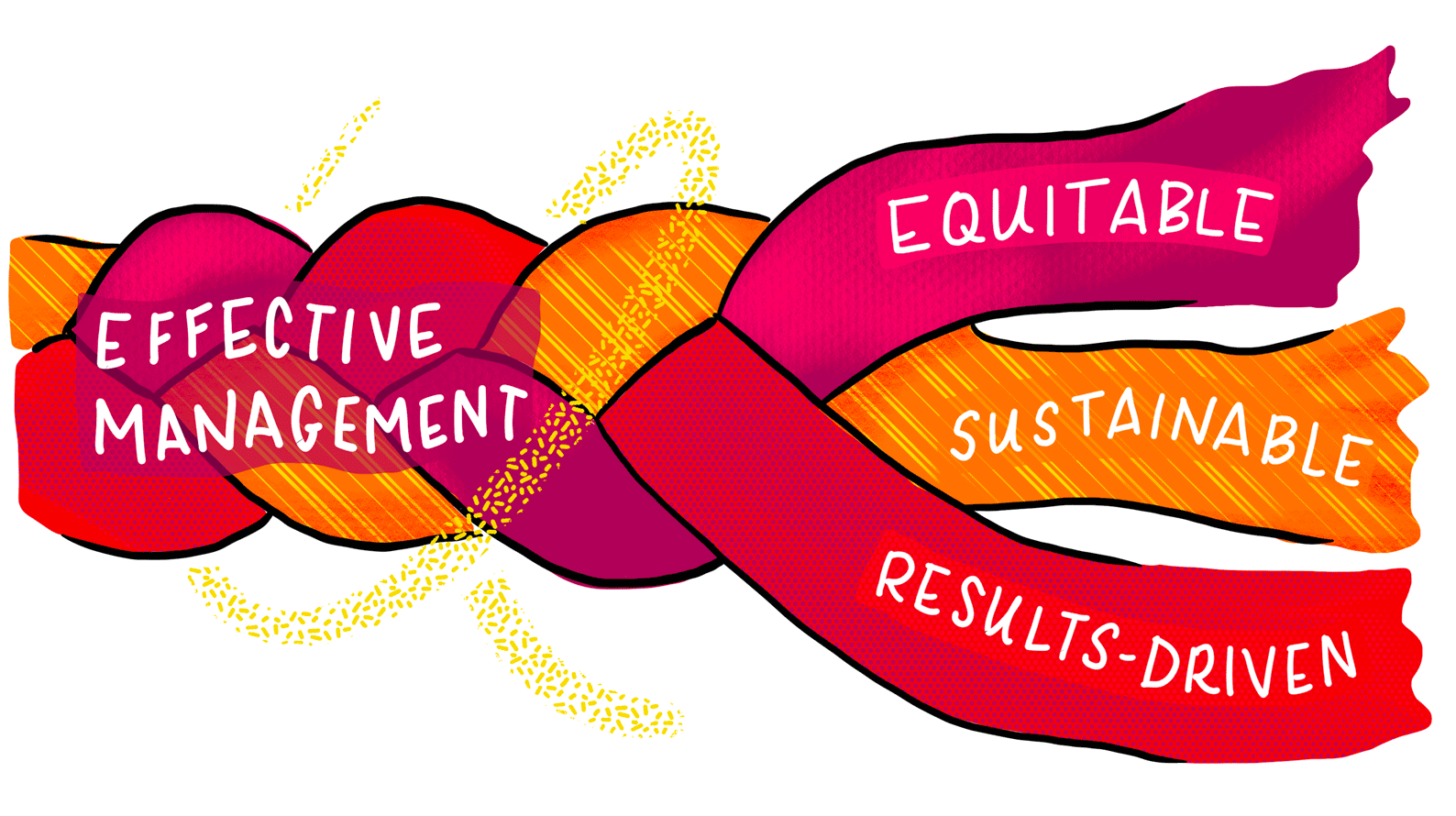Being a great manager is more than tools and techniques and knowing your way around a MOCHA. Don’t get us wrong—we love a great tool! But we believe that your management should be grounded in an overarching approach—a set of values or principles to guide your actions and decisions.
A clear approach will help you navigate both the routine and unexpected parts of being a manager. It’ll help you improvise when you confront unfamiliar challenges and contexts where there’s no playbook or quick fix.
Most importantly, for managers and leaders working for social justice and educational equity, an intentional approach helps you avoid defaulting to the status quo. This status quo looks like command-and-control, a style of management that values efficiency and productivity over all else—including diversity, inclusion, and belonging.
Have you ever worked somewhere where you felt like a cog in a machine? You were expected to execute someone else’s orders without being able to share your own ideas or offer any input. Or maybe you’ve been on a team where you had to compete with your colleagues for resources and recognition, even when you were supposed to be collaborating. Perhaps you didn’t even know why your work mattered in the long run or how it fit into the bigger picture of your organization’s goals.
That’s what happens under a command-and-control management approach.
But what if your work (and your staff’s) could be fulfilling and enjoyable? What if, even though there might be hard parts of your job, you felt valued, respected, and supported by your teammates and manager (and vice-versa)? Imagine a job where you have no doubt that your contributions are meaningful. You see how your efforts help your team and organization achieve your mission. You know that you belong.
At TMC, that’s what we’re after. And we believe that managers play a key role in making this experience a reality for their staff. That’s why we take a different management approach: conspire-and-align.
Conspire and Align
Conspiring and aligning means coming together with our team members for a collective purpose, and getting on the same page about how to realize that purpose. When we conspire and align, everyone understands where we’re going and what role they play in getting us there.

The word conspire comes from the Latin conspirare, which means “to breathe together,” and shares a root with the words inspire and aspire. When we conspire, we co-inspire our team with a shared, co-crafted vision of success. When we align, we get in formation—the way birds flock, dancers get in place, and people assemble at marches.
If conspiring sounds like you might be “up to something,” you’re right about that too! But we’re not talking about being sneaky or nefarious. We’re talking about making “good trouble,” as the late Rep. John Lewis put it, so that we can disrupt the status quo to advance social justice.
As managers, we view staff as partners—people we exercise power with, not over. But we don’t pretend power dynamics don’t exist; quite the opposite! The conspire-and-align approach is about recognizing power, being honest about it, and exercising it responsibly, for the good of the work, the organization, and your team. This approach can work in all kinds of settings—from more traditional hierarchical structures to flat or cooperative ones.
Many of you might already take a conspire-and-align approach to management. If you’ve ever brainstormed a vision of success with your team, sought input before making an important decision, or tapped your team’s knowledge and expertise to solve a tricky problem, you’ve conspired and aligned!
But command-and-control management is so pervasive that most of us have experienced it at some point (and can default to it). Perhaps you (like many of us) have picked up some bad habits along the way from these experiences, and you’re still working to unlearn them. You know there’s a better way—one that better reflects your values and commitment to social justice.
When we reframe management as an act of conspiring and aligning, a whole new world opens up. We gain a new understanding of what it means to manage effectively. And we adopt new mindsets and different tools to help us match our management practices to our values.
The Three Dimensions of Effective Management
Under the command-and-control style, management is considered “effective” as long as it’s “productive”—even if that “productivity” harms the well-being and dignity of employees, the greater good of society, or the health of our planet.
Under a conspire-and-align approach, on the other hand, we understand that management can only be truly effective if it has three dimensions:
Equitable
To get the best work from our team, we need to make sure all of our team members have what they need to succeed, and that none of them are being held back by disparate impacts or unfair treatment due to a marginalized identity.
Sustainable
We can’t afford to lose our co-conspirators to burnout! We must align with our team on a vision that’s both inspiring in the long run and achievable in the short run.
Results-driven
We’re here to get things done and make real change for the people and movements we care about. If we support each of our team members to make the best use of their talents, we’ll get much better results than we ever could on our own.

Equity, sustainability, and results are like three strands of a braided rope. The rope weakens if you try to separate the strands. Effective managers don’t play favorites—they don’t routinely focus on one dimension at the expense of the others.
The Three Mindsets of Effective Management
A conspire-and-align approach leads us to think about effective management in three ways:
Management is a practice
Like any craft or discipline, effective management is something we do. And those things we do can be broken down into fundamental component parts—skills and techniques that we apply over and over, like delegation, goal-setting, and relationship-building. We don’t get good at management just by reading, thinking, and talking about it. We figure it out through consistent and rigorous practice, which includes trying, making mistakes, experimenting, and (hopefully) getting better over time.
Management is a duty
We have a duty to our movements and communities to get the best results we can. Whether it’s registering enough voters to build local power or increasing math scores for 4th graders, we are doing this work because we feel a duty to make real change in the world. We also have a duty to our team members to exercise our power responsibly and to be good stewards of their time and energy. People spend a lot of their lives at work, and how we manage people influences whether they feel a sense of purpose or dread coming back the next day.
Management is a balance
To conspire and align effectively, we must learn how to balance seemingly competing ideas and priorities—like balancing our care for an exhausted colleague with our need to get a press release out about a horrible bill being proposed, or finding a balance between giving clear guidance and letting our team members truly own their work. “Balance” doesn’t just mean finding a compromise or happy medium; it can also mean switching between different approaches depending on the circumstance (like taking a week off after putting in extra hours for a sprint), or grounding yourself in two different values at the same time to stay stable (like caring for your people and committing to getting great results).
Tools for Putting Conspire-and-Align Into Practice
These are the five most important tools we use daily in a conspire-and-align approach to management:
- Sphere of control: Focusing your time and energy only on the things you can control, and letting go of the things you can’t.
- Choice Points: Turning off autopilot and pausing at every “fork in the road” to consider equity implications and alternative options for the decisions you make.
- PTR: Learning to tell the difference between preferences, traditions, and requirements (and focusing on requirements!).
- Make the implicit explicit: Taking the invisible expectations and assumptions you have in your head and articulating them.
- Seek perspective: Getting input from others, especially those most impacted by your decisions.
Conspire and Align Discussion Questions
We encourage you to share this article with your fellow managers and staff members to open a dialogue about practicing conspire-and-align in management. Use the questions below as a guide for conversation:
With fellow managers
- What parts of your current management style look more like conspire-and-align? What parts look more like command-and-control?
- What are some concrete ways you could bring the conspire-and-align approach to your management?
- What, if anything, is holding you back from implementing a great conspire-and-align management approach? (Examples might include: expectations from your manager, your organizational culture, the naysayer in your head, old habits, etc.)
- When it comes to either the three dimensions of effective management (equity, sustainability, results) or the three mindsets of effective management (management is a practice, duty, balance), is there an area that you have a harder time adopting or applying? Why?
With your staff
- What experiences have you had with the command-and-control style of management in prior jobs? What do you want me to know as your manager about those experiences and how they impacted you? [Ask if your staff would like to hear from you, too: if so, share your experiences and be honest about what you’re still unlearning].
- I’d love to get some feedback from you about my management. When it comes to seeking your perspective, being clear about our collective purpose, and having alignment, what am I doing well? What could be better?
- Equity, sustainability, and results are like three strands of a braided rope that weaken if you try to separate the strands. All three are essential to effective management. How am I doing as your manager to balance these three strands? Where could I be focusing more/less?
Want more? Buy our book and read more about conspire-and-align in Chapter 1. Order it here.